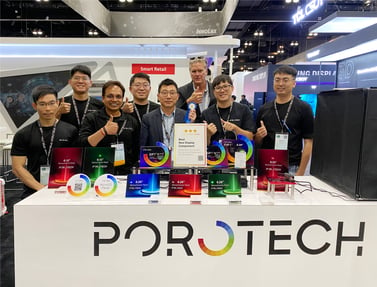 Stevie-winner Porotech specializes in developing microLED displays using global gallium nitride (GaN) material technology, with a proprietary approach to GaN-based red, green, and blue (RGB) microLEDs.
Stevie-winner Porotech specializes in developing microLED displays using global gallium nitride (GaN) material technology, with a proprietary approach to GaN-based red, green, and blue (RGB) microLEDs.
Porotech announced the world’s first demonstration of an "all-in-one" full-color display of microLED pixels in October 2022, driven by Porotech’s proprietary DynamicPixelTuning® (DPT®) technology that allows a single pixel to display the full-color spectrum.
Porotech’s disruptive DPT technology aims to revolutionize the display industry. While traditional microLED displays are made up of separate RGB sub-pixels to display full color, DPT technology allows a single microLED pixel to display any color in the visible spectrum, including bright white.
In traditional microLED displays, red sub-pixels are currently made with a different material to green and blue, creating a complicated supply chain, with high levels of waste and inefficiencies. However, Porotech has harnessed a new proprietary material, PoroGaN®, which can display any color on the spectrum. This simplifies and improves the design of the display and optical system and removes major manufacturing roadblocks.
With a monolithic pixel, colors are no longer constrained by the three primary colors, which significantly expands the available range. In addition, by replacing the traditional four sub-pixel format with a single microLED, this technology can increase pixel density of any given display four-fold. This creates substantial improvements in resolution and screen brightness, which is particularly important on small form factor displays, such as wearables and augmented reality (AR)/virtual reality (VR) headsets.
Similarly, a monolithic pixel can also lower costs and produce higher yields for large area displays such as video walls and automotive applications, as it eliminates two mass transfer steps in the manufacturing process.
Greater flexibility, simplicity, and lower power consumption of the whole optical design can be achieved when DPT is used as the basis for the technology, supporting the production of more sustainable displays. Furthermore, DPT removes the need for mass transfer, reducing the costly waste involved in microLED production and making DPT a supply chain-ready solution, massively simplifying display manufacture.
Described in 2023 as "the most impressive technology at CES" by display technology expert Karl Guttag, the improvements in resolution, color, brightness, and efficiency can revolutionize consumer technologies like wearables, AR, and VR.
The manufacturing benefits afforded by DPT requiring only one material to produce will solve expensive challenges that major corporate R&D teams have struggled with for years, with companies like Apple, Meta, and Samsung investing considerable resources into achieving a monolithic pixel.
Porotech is currently working with major original equipment manufacturer channel partners that will build DPT technology into their products to sell to consumers. Initial proof of principle projects will then develop into nonrecurring engineering co-developments and eventually IP licensing or manufacturing supply relationships to proliferate the technology across multiple applications and worldwide.
Since winning their Stevie® Award, Porotech has announced the world's first 0.26-inch monolithic full-color microdisplay, a significant milestone for both Porotech and the entire microLED industry, as only DPT pixels can meet the specification, performance, reliability, and cost required for AR glasses.
Porotech won a Gold Stevie Award for Emerging Technology Business Technology Solution in The International Business Awards®.
Interested in entering the 2024 edition?













